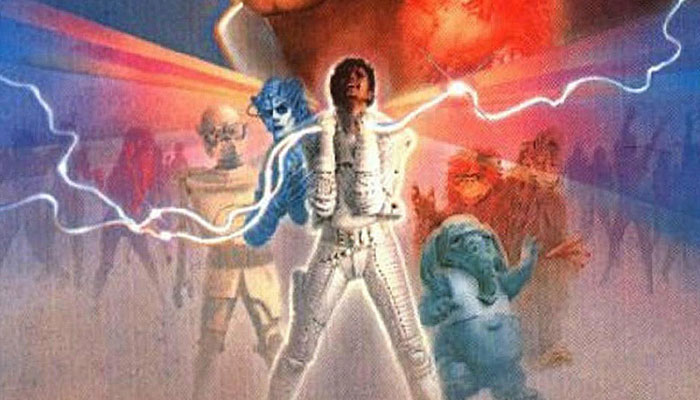Following the middling reception of 1984’s THE COTTON CLUB, director Francis Ford Coppola found himself slowly but steadily pulling out of the debt spiral that began with 1982’s ONE FROM THE HEART. Coppola could not afford to rest on his laurels, needing to work consistently to pay off said debt. As his next feature film project began to take the shape of 1986’s PEGGY SUE GOT MARRIED, Coppola first would tackle a project of a very different kind, one that endeavored to quite literally push the boundaries of cinema.
The mid-80’s was an interesting time to be in media. Conglomerations like Pepsi and Disney were tapping into American pop culture as a way to shill product. Michael Jackson, the King of Pop himself, became heavily involved in corporate branding and lent an aura of star power to commercial campaigns. His collaboration with Disney manifested in a short film/music video that would be played in the mouse house’s various theme parks as part of an integrated “4D” viewing experience. Titled CAPTAIN EO and originally set to be directed by Steven Spielberg, this experience would incorporate hydraulic seats, scent sprays, synced smoke, lasers, and a variety of other things to create an immersive ride that went beyond 3D’s stereoscopic imaging.
The script was co-written by Coppola’s friend George Lucas, who by this point had already completed his groundbreaking STAR WARS TRILOGY and was well familiar with spaced-based swashbuckling action. After Spielberg dropped out, Lucas’ old buddy seemed like a good bet to helm a project whose presentation lay in uncharted territory.
Due to its elaborate presentation, the story was appropriately simplified to feature Michael Jackson as Captain Eo, a brave space traveller who guides his crew to a dark, industrial planet in an attempt to breathe new life into its inhabitants with the help of music and dance. Jackson’s crew is populated by a variety of space-age Muppets, a robot, and a stop-motion animation butterfly/rat thing. Anjelica Huston is nearly unrecognizable as the Supreme Leader, Eo’s main antagonist. The Supreme Leader’s makeup and costume design is one of the strongest points of the film, fusing a cyberpunk aesthetic with the machinations of a spider.
While frequent Coppola cinematographer Vittorio Storaro apparently served as a lighting director, Peter Anderson gets the cinematographer credit for CAPTAIN EO. Anderson’s photography effectively captures the saturated, bright colors of Eo’s spaceship and the cold blacks of the Supreme Leader’s lair, in an inspired design from Art Director Geoffrey Kirkland. Coppola crafts a slightly cheesy, chintzy sci-fi aesthetic that harkens back to his Roger Corman days. Visual effects are quaint and intentionally shaky-looking, which I suppose adds a degree of charm. I imagine that experiencing CAPTAIN EO during its run in various Disney theme parks was a sight to behold, but I just so happened to view the film on Youtube, which came from a VHS recording of the only time the film was ever broadcast on TV. As you can imagine, it looked pretty terrible. And unless the Mouse House sees fit to release the short to the public, this shitty VHS dub is the best you’re ever going to get.
At seventeen minutes long, CAPTAIN EO is basically one big music video. And at a cost of $1 million dollars per minute of finished film, it also ranks as one of the most expensive films ever made (on a minute-by-minute basis). For those accustomed to the idea of Coppola as the esteemed auteur behind THE GODFATHER (1972), watching CAPTAIN EO comes as somewhat of a shock. It may even come off as a desperate, pathetic money grab on Coppola’s part—another rung lower in the fall from greatness. Personally, I see the film fitting quite comfortably into Coppola’s oeuvre, albeit in unexpected ways.
Coppola’s career-long pursuit of redefining cinematic language is given a rigorous exercise with the demands of an immersive theme park theatrical presentation. Not only did Coppola have to rely on sound and image to tell his story, but motion and smell as well. It’s a literal bursting forth from the constraining proscenium wall that had so beautifully contained his ideas in ONE FROM THE HEART.
Watching the film now, CAPTAIN EO feels inescapably dated, as if it were a forgotten relic of 1980’s pop culture. It enjoyed a brief resurgence when it was brought back to Disney theme parks in tribute form following Michael Jackson’s death in 2010, but the very nature of its conception means it can never be truly timeless like most of Coppola’s other works. That is the nature of pop—an art form that is so focused on being “of the moment” that it completely overlooks the fact that the chosen moment passes by all too quickly. At least Coppola’s foray into pop commanded a collaboration with no less than the King himself.
CAPTAIN EO is currently available on Youtube, via the embedded stream above.
Credits:
Producers: Rusty Lemorande, George Lucas
Writers: Francis Ford Coppola, George Lucas, Rusty Lemorande
Director of Photography: Peter Anderson
Editors: Lisa Fruchtman, Walter Murch
Production Designer: Geoffrey Kirkland
Music by: James Horner
